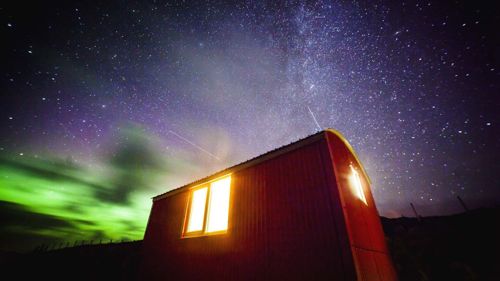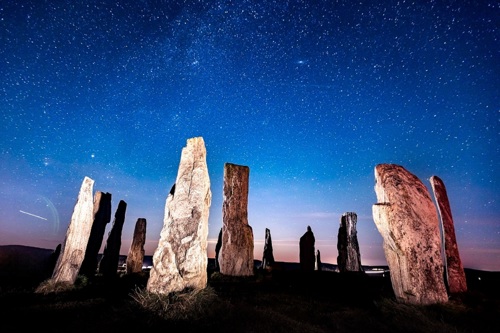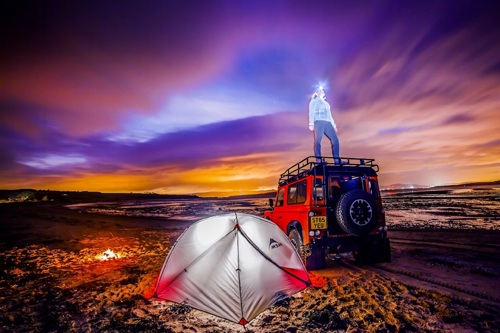Mobile menu
24 November 2024
Stunning Stargazing Spots in Scotland

Synonymous with romance and wonder, there is nothing more breath-taking than a night sky full of shimmering stars. The dark skies of rural Scotland gift us with some of the best star gazing opportunities in the UK. The west coast - with its limited light pollution and longer Autumn and Winter nights - offers some dream locations for budding star gazers.
Dark Skies on Coll

Where better to start this exploration of the west coast's best star gazing opportunities than with the wonderful Isle of Coll. Around 6 miles west of Mull, in the Atlantic, the Isle of Coll is a tiny island known for its warm welcome and its immaculate night sky. In summer, it basks in some of the longest hours of sunshine in the UK. In winter the long dark starry nights helped it gain Scotland's first, and only the world's twenty-second, 'Dark Sky Island' status. A huge achievement for a small island community.
Isle of Coll is around 20 miles from the nearest streetlight which means that almost anywhere on the island will offer you memorable views of the stars above. Added to that, the island is not mountainous, so there's no peaks and valleys which attract pockets of clouds, so the chances are the night-time skies will be clear as a whistle. There are three specific locations allocated on the island for night sky viewing - RSPB Totronald, Cliad football pitch and Arinagour - however, given its unique geography, the whole island offers excellent star gazing opportunities.
Although winter presents more opportunities to turn your eyes skyward, the best time for seeing the Milky Way on the Isle of Coll is usually during April and May, and then again in August and September. Coll's a particularly good location to see this given its more southerly position in the Hebrides.
Starry Skye

In addition to Coll's official 'Dark Sky Island' status, the Isle of Skye offers a number of official 'Dark Sky locations' - a nationwide network of beauty spots that provide great stargazing views, usually nominated by local groups as the best place to witness a flawless night sky.
Skye's 'Dark Sky locations' stretch from Armadale, Kinloch forest and Kylerhea in the south of the island to Waternish in the north. Beautiful spots with little to no light pollution and huge coastal skies which stretch for miles before you.
A festival for dark skies on the Outer Hebrides

Year round, the Outer Hebrides is a spectacular place to visit. The locations best known for their long summer days also offer spectacular winter nights. Again, with little to no light pollution plus uninterrupted views of the expansive sky (from the beaches of Lewis and Harris in particular), star chasers in the Hebrides are spoiled for choice. Tolsta and Hushinish beaches are notable star gazing sites, along with the atmospheric Calanais Standing Stones.
Each year, the Isle of Lewis on the Outer Hebrides hosts the Hebridean Dark Skies Festival Opens in new window at An Lanntair and across the island. Returning in 2024, the island will host a celebration of dark skies through an ambitious programme of music, film, visual art, theatre, talks and star gazing opportunities. Read more about the legacy of the event and see footage from previous years at the official website.
Your stargazing essentials

If you're new to stargazing and planning to soak up the spectacular starry skies of the west coast of Scotland, you'll need to plan ahead. Here are some of our stargazing essentials:
- The stars are most visible on clear nights, but clear skies mean things will feel cold! Don't underestimate the chill you might feel especially if you're stood still for long periods. Layer up in your warm winter woollies and perhaps bring a chair and a hot drink so you can sit and sip in comfort.
- Give your eyes time to adjust to the dark. Whether you've used a torch, the headlights of a vehicle or you've just left the indoors - your eyes will need a little time to adapt to the change in light. It's amazing how many more stars you'll see once you're half an hour into your stargazing session.
- Once adjusted, you can see so much without any equipment. However, if you bring a pair of binoculars, you'll be able to enjoy even more detail in the exquisite night sky.
If you can, perhaps do a little preparation by downloading an app to your phone - if there's a signal, it might help you identify what you are looking at, or you can check what might be visible before you go.
Scotland is a special destination for all kinds of reasons but enjoying a night of casting your eyes to the sparkling night sky is a pretty compelling one. Wrap up, pack the snacks, boil the hot chocolate and set off to catch a glimpse of one of life's great performances in one of the country's most exotic locations. Enjoy your evening among the stars - in this part of the world they offer the intrepid sky gazer a uniquely Scottish brand of peace and tranquillity.


